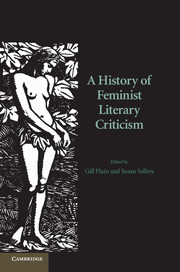Book contents
- Frontmatter
- Contents
- Acknowledgements
- Notes on contributors
- Introduction
- PART I PIONEERS AND PROTOFEMINISM
- Introduction to Part I
- 1 Medieval feminist criticism
- 2 Feminist criticism in the Renaissance and seventeenth century
- 3 Mary Wollstonecraft and her legacy
- 4 The feminist criticism of Virginia Woolf
- 5 Simone de Beauvoir and the demystification of woman
- PART II CREATING A FEMINIST LITERARY CRITICISM
- PART III POSTSTRUCTURALISM AND BEYOND
- Postscript: flaming feminism?
- Index
- References
Introduction to Part I
Published online by Cambridge University Press: 05 June 2012
- Frontmatter
- Contents
- Acknowledgements
- Notes on contributors
- Introduction
- PART I PIONEERS AND PROTOFEMINISM
- Introduction to Part I
- 1 Medieval feminist criticism
- 2 Feminist criticism in the Renaissance and seventeenth century
- 3 Mary Wollstonecraft and her legacy
- 4 The feminist criticism of Virginia Woolf
- 5 Simone de Beauvoir and the demystification of woman
- PART II CREATING A FEMINIST LITERARY CRITICISM
- PART III POSTSTRUCTURALISM AND BEYOND
- Postscript: flaming feminism?
- Index
- References
Summary
The history of feminist literary criticism properly begins some forty or fifty years ago with the emergence of what is commonly termed second-wave feminism. The history of this critical movement and its impact on culture and society will be charted in the second and third parts of this volume, but it is important to recognise that this story has a prequel. To write of pioneers and protofeminism is to explore the diverse texts, voices and lives that articulated feminist ideas and feminist critical positions before such categories existed. Medieval women were not ‘feminists’ and they had few opportunities to be critics, but as Carolyn Dinshaw observes in the opening essay, ‘texts affect lived lives, and … if women had relatively little opportunity to author texts, they nonetheless felt their effects’ (Dinshaw, 15). The history of women's engagement with texts and textuality far exceeds the parameters of second-wave feminism, and this history is integral to contemporary understandings of feminist practice.
Yet the history of the representation of women, their writing, their reading and their literary critical acts would in total need not a single volume but a library of texts, and in consequence Part I of this book sets out a combination of overview and example that indicates the complexity of feminism's origins without attempting an exhaustive survey. The overview begins with the first two chapters, Carolyn Dinshaw's ‘Medieval Feminist Criticism’ and Helen Wilcox's ‘Feminist Criticism in the Renaissance and Seventeenth Century’, which together establish the conditions of pre-Enlightenment female subjectivity.
- Type
- Chapter
- Information
- A History of Feminist Literary Criticism , pp. 6 - 10Publisher: Cambridge University PressPrint publication year: 2007
References
- 1
- Cited by

